Run, Jeb, Run! (Number 394 in a Series)

GREAT NEWS AMERICA. We might get a Jeb Bush candidacy yet! The news is a-flurry with Jeb Bush news, though actual flurries have canceled his flight to D.C. today so he will not be Making News at the Cato Kaelin Institute tonight, with his pronouncements about the future of our race wars.
Question: “Is Jeb Bush the Republicans’ Hillary Clinton?
Answer: No.
Question: What does this mean? “I’m not saying yes, I’m just not saying no. I’ve accomplished some things in my life that allow me now to — to have that kind of discretion, to be able to think about it.”
Answer: He made lots of money.
Question: Will Jeb Bush Run?
Answer: Yes, they will run Jeb Bush if the Democrats have a lock on the White House for 2016, which, from here, looks likely. Although Obama could destroy that handily over the next three years, so, STAY TUNED.
JebWatch2016 is brought to you by the fine people who brought you JebWatch2010 and JebWatch2012 and various other Jeb Bush related insanities.
Hugo Chavez Memorialized
Hugo Chavez Memorialized
Was Hugo Chavez a demagogic despot who cloaked his dictatorial tendencies in long-winded rhetoric about his love for the poor or a champion of an underclass who had spent too long in brutal subjugation to a wealthy elite who cared little and did less for them? Either way, he’s dead now, which means his life must be recounted in cut-rate CGI from Taipei. This is the world in which we live.
DJ Paul, "In My Zone"
https://www.youtube.com/watch?v=xhP4XmbQUZ8
Well, this is very disturbing. In an apparent effort to challenge his old Three 6 Mafia partner Juicy J for the title of hip-hop’s “No. 1 get-high rapper,” the self-proclaimed “King of Memphis” DJ Paul does so many drugs in his new video that he has a heart attack and dies. (Kids don’t follow!) Calling oneself the “King of Memphis” is pretty cool, though, in that it places DJ Paul in the line of Old Kingdom Egyptian pharaohs like Menes and Djoser, under the protection of the god of carpentry and metalworking, Ptah, or “Lord of Truth.”
Pick Your Slushy Poison of Delight
WINTER IS COMING. Very mildly perhaps. Let’s try that again. DRIZZLE IS COMING. But also, a kind of amazing New York City evening of culture. Let’s check the calendar!
'Mommie Dearest': Once More With Wire Hangers
‘Mommie Dearest’: Once More With Wire Hangers
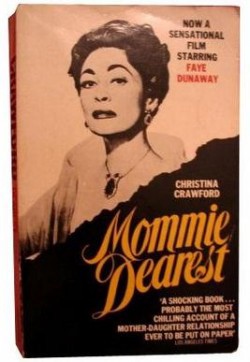
It’s remarkable that we’ve been doing this feature for over a year, and are only now cracking the weathered covers of Christina Crawford’s masterpiece. When I say “weathered,” I mean it: my copy is from 1980 and informs us that said book is “SOON TO BE A MAJOR MOVIE STARRING ANNE BANCROFT AS JOAN CRAWFORD.” Some of you may have missed it, so let’s review:
“…ANNE BANCROFT AS JOAN CRAWFORD.”
What a world that would have been, no? Setting aside the question of how Ms. Bancroft would have tackled the role, can we address the hypothetical arc of Faye Dunaway’s career had she never hacked up a rose bush or strangled a young girl? I mean, this is a woman who was in Chinatown and Network. The sky was the limit. One must conclude that Anne Bancroft took a second look at the script and decided that she would only wear cold cream in the privacy of her own room.
But, of course, the movie is its own magnificent beast. If you want to know more about the movie, I cannot recommend John Waters’ commentary on the 2006 DVD re-release highly enough. The man takes his biopics seriously. Today, however, we are concerning ourselves with the book. Excelsior!
For the recently unfrozen caveman lawyers among you, Mommie Dearest is a lurid first-person account of Christina Crawford’s abusive childhood at the hands of a truly cinematic Joan Crawford. She was not the first and will not be the last celebrity to receive such treatment in print: Bing Crosby, voted “the most admired man alive” in 1948, was the subject of a hair-raising portrayal by his son Gary, and two of his other sons eventually committed suicide, so, generally, our lesson here is: do not abuse your children, if you were considering it, and seek help for your mental illness and substance abuse issues as soon as they become apparent.
Now, the extent to which Christina’s account is completely truthful has always been a little hazy. Joan’s dead, it was years before Kim Basinger could leak your ranting voicemails to the press, and for every acquaintance who was willing to defend her memory publicly, there’s another who said that bitch was even crazier than Christina let on. Let us, therefore, treat Mommie Dearest as the ripping yarn it is, and let the celestial court try Joan Crawford on its own.
SUCH a ripping yarn. It’s frequently described as “Dickensian,” an adjective which has come to mean “super cruel and shitty,” which might have surprised Dickens, as many of his characters had normal, pleasant lives punctuated by large meals ending in plum pudding. Moreover, Crawford’s childhood was certainly not marked by a great deal of privation, so perhaps “Crosbian” would be more apt. “Crosbian”: a childhood in which relative material luxury is coupled with frequent beatings and erratic bursts of rage, directed either at you or plants or your bathroom vanity. That’s pretty much what went down. It sounded pretty grim.
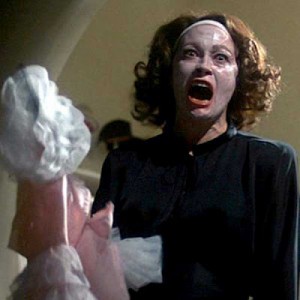
Now, all accounts of being knocked around by your loathsome parents are pretty much the same (I mean, this is not meant to excuse such acts, most bowel obstructions are fairly similar, but no one wants one), so to really stand out, you need to showcase the more bizarre forms your familial abuse took. “Get to the wire hangers,” I hear you saying. Ah, yes, the wire hangers. Now, to be fair to Joan, wire hangers are pretty bad. They can get rust spots on your light-colored clothes, they warp, they have dangerously pointed edges, etc. But, generally, when you are a child, you do not necessarily spend 24/7 policing the things your middy blouses are perched on in your closet. Or, whatever, probably the Brant Brothers did. (Love/hate/obsess over them.) ANYWAY, this is that famous thing where Joan busts into Christina’s room in the middle of the night and goes apeshit because she found a wire hanger in her closet. Many things in life are overhyped, but I can assure you, reading that scene is not. Then again, many things in life would be even better if acted out by Faye Dunaway, and this IS one of those things. Oh, here, let’s type “wire hangers” into YouTube. So many choices! So many tributes. Let’s pick the high-def version. Enjoy!
Most of this book is a little heavy on the “and I was in THIS school, but then something something and she sent me to THIS school instead, something something came home for winter break and there was a rando guy around that I was supposed to call ‘Daddy’ for a week” explication, which, you know, that’s bad and everything, but for true outrage, I have traditionally fixated on the fact that Joan would film the kids delightedly unwrapping their Christmas presents every year, and then once the cameras left would confiscate them and regift them throughout the year at parties. Which is unfair of me, because that’s probably not, like, the worst parenting tactic for super-rich people, really, it’s the SMUGNESS of it, you know? You can’t mess with presents given to others. It’s not cool.
But, the worst part? The worst part of that thing which, even as I am typing it, I realize is not so terrible after all? They still had to write the thank-you notes. Thousands of thank-you notes for gifts they weren’t allowed to keep. The humanity! The humanity. Burn the witch. Burn her.
Okay, let’s dish!
DISCUSSION QUESTIONS
• Over the next fifty years, the children of current stars will be publishing their own tell-alls. Which one are you MOST excited for?
• Do you think it will be an obvious suspect (Britney), or will it come completely out of left field (Jennifer Garner)?
• What’s the deal with cold cream, anyway? Is it for removing makeup or is it a moisturizer?
• Did you know there is a Wikipedia page for “Psycho-biddy,” the film genre in which older women go crazy, a la “Hush…Hush Sweet Charlotte”?
• Did you know Faye Dunaway turned down Ellen Burstyn’s role in Requiem for a Dream?
• You should keep in mind that Faye Dunaway’s first role after Joan Crawford was as Eva Peron, so she’s never shied away from combat zones. Did anyone else really, really love Madonna’s Evita? No? Just me? Forever alone?
• Seriously, no one else lip-synched in their bedroom to Madonna’s part in “Good Night and Thank You”?
• Did you read Harry Brant on his skincare regimen in Into the Gloss?
Previously in Classic Trash: ‘IT’: Seriously, Guys, Get Out Of Maine Before You Die Terribly
Nicole Cliffe is the books editor of The Hairpin and the proprietress of Lazy Self-Indulgent Book Reviews.
New York City, March 4, 2013

★★★ Morning brightness caught in the thickening lace of the treetops, and it caught in the still-steaming breath of pedestrians. The buds were reddish and the river bluish. When does being beautiful but cold cease to be enough? The beauty is an episode; the cold adds up. Smokers angled their bodies partway against the breeze but stood and chatted on the corner. The sunny side of the street argued, unsuccessfully but perhaps rightly, against following the walk sign over into the chilly shade.
Great White Shark Is California's Newest Cuddly Endangered Species

The great white shark is a majestic and terrifying animal, as you may have seen in videos, but it has also been mercilessly hunted by heartless creeps who hate nature. The great white is more than a sea monster, of course: It is a crucial part of the ocean environment, acting as the grim reaper for sad and sickly sea critters who would otherwise require entitlements to live out their old age.
As of February, the majestic killing machine of the deep is protected by California’s Endangered Species Act. Sports fishing of the sharks has been illegal since 1994, but a lot of juvenile great whites get caught up by industrial seafood fishing nets. And because nobody has no idea what kind of fish is served in restaurants or sold in stores, regardless of the label’s claims, you are probably eating a lot of innocent shark right now, in your “spicy tuna roll.”
Under the new protections, anyone with these endangered predators will be fed to the sharks thrown in a prison in the Central Valley with Charles Manson. Or the fish processing plant will pay a small fine, one or the other.
Photo by Hermanus Backpackers.
This Is A Longreads On The Internet: The Inroads Of Slow Art In A Fast Culture
This Is A Longreads On The Internet: The Inroads Of Slow Art In A Fast Culture
by David Zweig
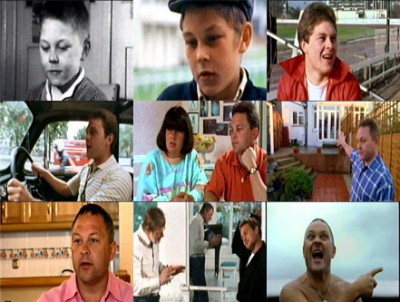
The British documentary 56 Up, the latest installment of the renowned 50-year-long Up Series, had its stateside theatrical premiere earlier this year. The Up Series has followed the lives of the same 14 Britons since 1964, revisiting them every seven years. This “remarkable” and “ever-evolving masterpiece” has a fervid and growing international following, and the past several installments that PBS aired after U.S. theatrical runs garnered viewerships in the millions. Every new Up installment is not just a window into the subjects’ worlds, but a powerful, ruminative event, forcing us to reflect on the passage of time in our own lives in a way that no single film could ever achieve.
The series is unique for the sheer expanse of the time it covers, but it’s only one example of the way other long-term or “slow art” — where either the creation or reception of the work is a purposefully slow process — is taking root across our culture. At first this trend seems surprising. We live in an ephemeral time, where obsolescence — of news, devices — is ever quickening, and quarterly-results-type thinking pervades our expectations in economic and political spheres. Or as media theorist Douglas Rushkoff, whose forthcoming book Present Shock deals with this subject, described our circumstances to me: “the relentlessness of the immediate, simultaneous, always-on society we live in.” Yet as the natural order always seeks balance, an era of impatience demands a corrective. More and more, it seems, people are seeking permanence from art both as a reaction and remedy to the anxiety imbedded in our culture of impermanence.
The slow movement as a whole — slow food, fashion, parenting, etc. — can be seen in this counteractive light. But there is a specific importance, a spiritual and emotional power of art — which I’m defining broadly to include any media that strives to enlighten — that has the capacity to steady our psyches in a way that other experiences and behaviors do not as often or as easily. After all, how many of us have the financial or logistical means for an Eat, Pray, Love-style transcontinental journey into the self, or for harvesting our own dinner? But slow art, if you’re willing to look for it, is but a click of the remote, trackpad or, for the diminishingly outgoing among us, trip to the theater away.
***
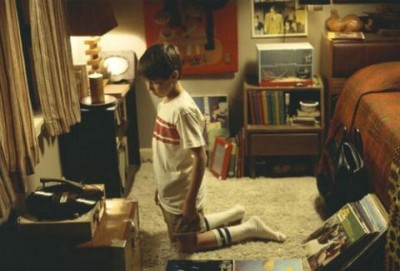
One of the hotly discussed cultural shifts in the past decade has been the resurgence of singles as the dominant musical format. In the early years of rock and roll, singles — sold as 45s — were the marquee format. From roughly the late 60s through the early 2000s, however, albums reigned supreme. The reasoning behind this, from the record labels’ perspective, was of course monetary: records, and later CDs, generate bigger profits than singles. But for artists and fans desiring a more complete and complex statement than what three-minute songs typically embody, albums offered the possibility of a more sophisticated narrative — either thematically speaking, or literally, in the case of concept albums — to become immersed in. Today, though, due to several factors, including the ease of file sharing; the dominance of digital retail structured around per-song sales/downloads, most notably iTunes; and the multi-artist song-focused formats of the Spotify playlists and Pandora stations that monopolize how many of us listen to music today, the cultural pendulum at large has swung back toward experiencing music on a per-song basis, not 45-minute artistic statements.
And yet despite the discouraging techno-cultural environment, not only has the album not died, there’s much evidence of a hunger for it. It’s almost obligatory now for a certain type of trend-setting band, such as Death Cab for Cutie or The Flaming Lips, to release new long-play albums on vinyl. The format has seen a massive sales uptick, more than quadrupling from 2007 to 2012. Part of the vinyl sales can be chalked up to a faux-nostalgia of millennials seeking a perceived “authentic” format for their music, as well as to fidelity aficionados who seek vinyl for its believed sonic superiority, but these reasons hardly can account for sales growth charting at a 45-degree incline.
Alec Bourgeois, of the legendary D.C. independent label Dischord, talked about his label’s exploding vinyl sales in an interview with the Washington City Paper, where it was suggested that there is a continuing allure of full albums for serious fans [emphasis mine]. In an article on vinyl’s resurgence among millennials in The Daily Universe, a BYU college paper, Corey Fox, an owner of a live music venue and a fixture of the Provo music scene for decades, put it well: “Most bands have a purpose to what they’re doing. I mean you’re supposed to put [the album] in and listen from beginning to end and it takes you on a journey. Now, it’s an industry of singles. I listen to music to get an emotional connection and I don’t think you get that from the ‘hot single.’ It’s fun to dance to, it’s fun to drive to and if that’s all you care about music for, that’s one thing. But there’s a lot of people in the music industry and fans of music that want more than that from their music.”
Length in and of itself has virtue. Vinyl strongly encourages one to listen to a side at a time. When you put an album on a turntable you submit to a different experiential frame — one that positions you for a 20-plus-minute commitment to one artist’s vision. The technology itself fundamentally changes how one experiences music. Often you listen to tracks you may not love because you’re too lazy to get up to lift the needle to the next track. (Even with CDs, where it’s easy to advance tracks, this can happen. There’s something about knowing the song you’re listening to is part of something larger that encourages one to take the format on its terms.) And an interesting thing happens — songs that at first were a bore or even objectionable, sometimes, magically, reveal themselves to be the best tracks. This approach to music listening offers an instructive corollary to the much-lamented dangers of our a la carte, personalized news consumption today. It’s critical for both our spiritual and intellectual well-being to be exposed to stuff we don’t immediately want to be exposed to. In the right circumstance, this is one of the virtues of slow art.
***
In this sense, your Spotify playlist or iTunes shuffle, in all their scattershot glory, fit under the umbrella of Nicholas Carr’s The Shallows, a treatise on how the interface and vastness of the Web encourages “shallow” rather than deep thinking. But something strange has been happening in the shallows of our Internet media consumption, as we restlessly click from blog post to charticle to HuffPo “quick read”: long-form journalism is thriving. Interestingly, links to in-depth pieces, via sites like Longreads, are particularly popular on Twitter. It seems an engaged minority are harnessing the connective power of social media, that too often is so shallow and disjointing, to promote and celebrate in-depth writing. As BuzzFeed editor Ben Smith suggested in an AdWeek piece (one of a wave of articles covering the trend), “People like sharing things that reflect well on them, and there’s a prestige attached to the longform hashtag.” His point indicates there is an inherent acknowledgment that long-form pieces offer not just more quantity, but quality as well.
But it’s not just about an intellectual putting on airs; people really are reading the pieces. In the AdWeek article, James Bennet, editor in chief of The Atlantic, noted that Longform, a site that links to excellent current and old long-form articles, “has had a very powerful effect on our overall audience in the last year.” In fact, “Have You Ever Tried to Sell a Diamond?”, a nearly 10,000-word, 30-year-old article, regularly appears “at the top of TheAtlantic.com’s traffic reports.” In an interview on AllThingsD, New Yorker editor David Remnick talked about how there is still a “human hunger for deep information, real examination, and the kind of reporting that takes time.” And, he mentioned, to that end, the Web has been a “godsend” for his magazine. The structure of the Web, so oft-noted for its bias toward brevity and encouraging users to flit around, also is proving to be a terrific platform for advancing in-depth writing. Clearly, readers are increasingly seeking a nutritious complement to all those sugar-pellet news bits.
***
Perhaps most insurgent is the variety of ways slow art is flourishing in visual media. It’s cliché at this point to deride YouTube as the land of inane cat videos and the like, and not without reason. But long-term projects, with intentions of being more than just entertainment, abound on the site. Among the more fascinating examples of these are the “picture of myself every day for X number of years” time-lapse montages. In turns tedious and recondite, over the minutes they allow us to watch the human face incrementally morph as it ages over the years. While these video projects highlight the profound, and potentially worrisome solipsism required of their creators, they also betray an extraordinary dedication and time commitment to one idea rarely seen, not only in the art world but in any endeavor in our culture. (If it hasn’t been done already, someone should be writing a dissertation on them.)
“Noah takes a photo of himself every day for 6 years” has been viewed over 24 million times. And amidst the ocean of obnoxious and glib comments that populate YouTube, these videos also elicit an unusual number of earnest reactions. “This video makes me so sad! it’s like time is passing us by, and we all age so quickly, and before you know it, life is over” remarked one commenter under Noah’s montage. In his follow-up, the near 8-minute-long “Noah takes a photo of himself every day for 12.5 years,” enhanced by an eerie, spare electronica soundtrack, the work takes on additional gravity. These types of videos don’t get circulated as widely as the one-minute silly stuff, but they are having a deep effect on many who come across them, including pushing some to embark on creating their own montages. One recent comment, of the over eight-thousand for this sequel, is “I remember watching his 6 year video 3 years ago and being inspired by it. I’ve now actually made a 3 year everyday video!” Photo-a-day videos of children (a related genre, presumably created by the subjects’ parents), have their own, in some ways wholly different value. “Natalie Time Lapse: Birth to 10 Years Old In 1 Min 25 Sec,” maybe because of the speed of its time-lapse, feels whimsical at first. Yet, ultimately, proves more affecting than the self-pic videos made by adolescents and adults. At first I wasn’t sure why. But scrolling through the comments it became clear. Many of them noted how Natalie smiled less as she got older. The top comment at the time of this writing is, “When she started school, she became sad :))” The inexplicable inclusion of the smiley face emoticon adds an extra dimension to the whole topic that warrants an analysis all its own.
Another area of filmed slow art gaining traction is the proliferation and acclaim over the last several years of long-arc TV series, where plotlines extend throughout a season or multiple seasons. This runs in contrast to the episodic plots that dominated highbrow television for the past 30-plus years. Instead of everything predictably being wrapped up in an hour, scripts and characters are given a chance to breathe, and richly develop, at their best more closely resembling and reflecting life. When the long-arc is done superficially like a soap opera, the narrative merely functions as a cliffhanger device to keep viewers returning. One can feel the contrivance of yet another melodramatic plot twist in an attempt to keep us hooked. This frustratingly became the case with “Downton Abbey,” as more deaths, miraculous paralysis recoveries and the like occurred with increasing regularity. But when done with nuance, such as the complex ebb and flow of character growth, regressions and stasis of “Mad Men” (anti)hero Don Draper over the course of a season, even multiple seasons, entertainment is elevated to art.
What may turn out to be an amalgamation of the time-lapse video montages, Up Series subject revisits, and long-arc fictional narratives, is Richard Linklater’s film, Boyhood. A twelve-year project, which will wrap shooting next year, Linklater has been filming the same core group of actors, shooting them for a short stretch once each year. The film, starring Ethan Hawke and Patricia Arquette, chronicles the life of divorced parents and their son, who we will watch grow from age 6 to 18 during the film. Most affecting will certainly be the young boy, played by Ellar Salmon, as we witness him age on screen during those formative years. As Hawke — whose work with Linklater on the Before trilogy became another long-form project — said in an interview with IndieWire, “About 20 minutes, your eyes just start tearing up and you don’t even know why. It’s about the nature of time and how it’s crashing into us all.” In a separate interview on the movie blog Flixist, Hawke elaborated, “In just the period of a two-hour movie, you watch a human being grow up. It’s almost like watching a flower bloom in time-elapsed photography. For one minute you’re watching a six-year-old boy, and it’s so beautiful what Richard does with time: you don’t ever see him go from six to seven, to seven to eight, to eight to nine.” He added, “I think it’s the greatest thing that Linklater’s ever done. It’s mind-blowing.”
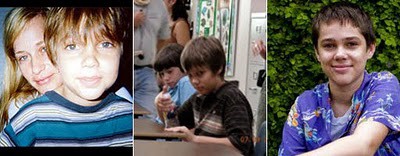
So perhaps it is with a lack of awareness, rather than hubris, that director Michael Apted, who has been with the Up Series since its first installment, 7 Up, in 1964, said to me, “My feeling is no one is ever going to do this again.”
Apted, who has shot classics like Coal Miner’s Daughter and Gorillas in the Mist as well as blockbusters like The World is Not Enough and a Chronicles of Narnia sequel, has a long history with the powers and purse-string holders of the movie business. He explained that unlike when he began in the 60s, when there seemed to be more stability with the companies that make film, today “it’s so fragile. The ground is so uncertain underneath in broadcasting and communications that no one is going to say ‘let’s invest in this for the next 50 years.’” And beyond financing, Apted noted, there are the insurmountable copyright issues that would occur if a long-term production switched from one financier to another, as each would retain the rights to the earlier material, making it impossible to use in subsequent installments. Of course Boyhood is twelve years in the making, not fifty, and it’s not a documentary, but its longitudinal nature ties the projects together. And so one can’t help but be slightly more optimistic than Apted about the possibility of other long-term film projects, perhaps not done quite like the extraordinary Up Series, but in different and still powerful ways, like Boyhood. Linklater, thus far, has found a way to finance the film and retain the actors for the duration.
There’s no doubt that the viewership of “Mad Men” is, of course, limited relative to “Big Bang Theory”-type ratings. However, it’s fair to say that the show’s cultural impact is larger than its viewership because of its amplified media coverage. And, yes, more people are spending time on banal Facebook updates than in-depth articles and essays. But I suggest that the people who are engaged with these slow-art projects — the Up Series viewers, the Longreads followers, whoever is going to watch Linklater’s Boyhood — include many of the same influencers who launch cultural trends, and so we’ll be seeing more of this work making inroads into the larger populace. This isn’t to claim that slow art will ever be the cultural ethos, only that it will persist, and perhaps grow, as a critical reaction to, or even refuge from the sped-up culture at large.
Rushkoff, the media theorist, concurred: “The art and media many of us are attracted to these days helps serve as markers in the timeline.” Adding, “It’s the way a roadside billboard can actually help you on the highway, creating a singular point of focus as you drive.” As the technologically-induced speed of everything continues to exponentially increase, people will desire, indeed, require, time-slowing havens to ground us, let us pause, and reposition how we experience and interpret the world.
If you don’t catch 56 Up in theaters this spring, you’re in luck — PBS recently purchased the US television rights and plans to air the film next fall.
Related: Why Does Vinyl Sound The Best? A Chat With A Musician Who Knows
David Zweig is the author of the novel Swimming Inside the Sun, and the forthcoming Invisibles (Portfolio/Penguin), a book about the power of anonymous work. He writes regularly about the intersection of technology, media, and psychology for a variety of publications, including The New York Times and The Atlantic, among others. His website is here.
The Higgs Boson Made Simple
“What is the Higgs field? It’s hard to visualize, so many people resort to metaphor. The Higgs field has been called a kind of cosmic molasses, pulling and dragging particles as they move through it. It’s been compared to a room of paparazzi, blocking the way of celebrities but letting nobodies through without a fuss. And it’s been likened to The Force from Star Wars, which ‘surrounds us and penetrates us’ and ‘binds the galaxy together.’
“
But we’ll use an amorphous cloud of nothingness.
The concept of infinity meets little resistance, gliding easily through the amorphous cloud.
The human soul shuffles by on a ghostly plane, fast but still slowed by the nothingness.
And God lags behind, plodding and tripping with every step.
The Higgs field is like our amorphous cloud of nothingness, but instead of nothingness, it’s made up of magic.
Particles that interact with the magic are changed somehow. They become, I dunno, “heavier?” An electron barely interacts with the magic, like the concept of infinity, and looks like the number 8, but laid on its side.
The quarks that make up protons and neutrons interact more strongly, like the human soul, and are immortal — destined to spend eternity either in heaven, eating whatever they want and without ever gaining weight, or in hell, sitting on a scratchy sofa in wet bathing suits watching Anne Hathaway and Jake Gyllenhaal in Love and Other Drugs on an endless video loop. Depending on whether or not they believe in …
… Massive, plodding particles like the W and Z bosons.
Photons and gluons don’t interact with the Higgs at all. They float like dust motes in a sunbeam coming through a window in a cafe in Paris, except the cafe does not serve coffee, only tea, and the window is not a window made of glass — it is a brick wall. How is light coming through it?
Fifty years ago, physicists had no idea why some particles were more “somethingy” than other particles.
So they thought up the Higgs to explain the difference. Remember when Hegel finally synthesized the subjective/objective capabilities of the human mind, declared himself the logical endpoint of human thought and wrote a book about that no one understands but they still make you read and write a paper about in philosophy class? Think about the color of the sky before there was such a thing as color.
It’s basically like an invisible extra dimension, responsible for everything that we can perceive in our world, but no one knows for sure whether or not it exists.
Also, time.

